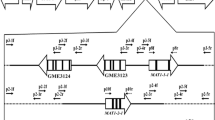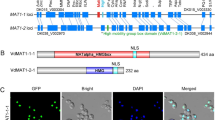Abstract
The homothallic Neurospora species, N. africana, contains sequences that hybridize to the A but not to a mating-type sequences of the heterothallic species N. crassa. In this study, the N. africana mating-type gene, mt A-1, was cloned, sequenced and its function analyzed in N. crassa. Although N. africana does not mate in a heterothallic manner, its mt A-1 gene functions as a mating activator in N. crassa. In addition, the N. africana mt A-1 gene confers mating type-associated vegetative incompatibility in N. crassa. DNA sequence analysis shows that the N. africana mt A-1 open reading frame (ORF) is 93% identical to that of N. crassa mt A-1. The mt A-1 ORF of N. africana contains no stop codons and was detected as a cDNA which is processed in a similar manner to mt A-1 of N. crassa. By DNA blot and orthogonal field agarose gel electrophoretic analysis, it is shown that the composition and location of the mating-type locus and the organization of the mating-type chromosome of N. africana are similar to that of N. crassa.
Similar content being viewed by others
References
Beach DH, Klar AJS (1984) Rearrangements of the transposable mating-type cassettes in fission yeast. EMBO J 3:603–610
Beadle GW, Coonradt VL (1944) Heterocaryosis in Neurospora crassa. Genetics 29:291–308.
Bender A, Sprague GF Jr (1987) MATα1 protein, a yeast transcription activator, binds synergistically with a second protein to a set of cell-type-specific genes. Cell 50:681–691
Berlin V, Yanofsky C (1985) Isolation and characterization of genes differentially expressed during conidiation of Neurospora crassa. Mol Cell Biol 5:849–855
Bistis GN (1981) Chemotropic interactions between trichogynes and conidia of opposite mating-type in Neurospora crassa. Mycologia 73:959–975
Bistis GN (1983) Evidence for diffusible, mating-type-specific trichogyne attractants in Neurospora crassa. Exp Mycol 7:292–295
Blakeslee AF (1904) Sexual reproduction in the Mucorinae. Proc Am Acad Sci 40:205–319
Devereux J, Haeberli P, Smithies O (1984) A comprehensive set of sequence analysis programs for the VAX. Nucleic Acids Res 12:387–395
Dodge BO (1935) The mechanics of sexual reproduction in Neurospora. Mycologia 27:418–436
Egel R, Gutz H (1981) Gene activation by copy transposition in mating-type switching of a homothallic fission yeast. Curr Genet 3:5–12
Forney RM, Miyakoshi J, Day RS, Paterson MC (1988) Northern blotting: efficient RNA staining and transfer. Focus 10:5–7
Garnjobst L (1953) Genetic control of heterocaryosis in Neurospora crassa. Am J Bot 40:607–614
Glass NL, Lee L (1992) Isolation of Neurospora crassa A mating type mutants by repeat induced point (RIP) mutation. Genetics 132:125–133
Glass NL, Vollmer SJ, Staben C, Grotelueschen J, Metzenberg RL, Yanofsky C (1988) DNAs of the two mating-type alleles of Neurospora crassa are highly dissimilar. Science 241:570–573
Glass NL, Grotelueschen J, Metzenberg RL (1990a) Neurospora crassa A mating-type region. Proc Natl Acad Sci USA 87:4912–4916
Glass NL, Metzenberg RL, Raju NB (1990b) Homothallic Sordariaceae from nature: the absence of strains containing only the a mating type sequence. Exp Mycol 14:274–289
Gough J, Murray N (1983) Sequence diversity among related genes for recognition of specific targets in DNA molecules. J Mol Biol 166:1–19
Griffiths AJF (1982) Null mutants of the A and a mating-type alleles of Neurospora crassa. Can J Genet Cytol 24:167–176
Griffiths AJF, DeLange AM (1978) Mutations of the a mating type in Neurospora crassa. Genetics 88:239–254
Kassir Y, Simchen G (1976) Regulation of mating and meiosis in yeast by the mating-type region. Genetics 82:187–206
Klar AJS, Fogel S, Lusnak K (1979) Gene conversion of the mating-type locus in Saccharomyces cerevisiae. Genetics 92:777–782
Logemann J, Schell J, Willmitzer L (1987) Improved method for the isolation of RNA from plant tissues. Anal Biochem 163:16–20
Mahoney DP, Huang LH, Backus MP (1969) New homothallic Neurosporas from tropical soils. Mycologia 61:264–272
Metzenberg RL, Glass NL (1990) Mating type and mating strategies in Neurospora. BioEssays 12:53–59
Metzenberg RL, Grotelueschen J (1992) Restriction polymorphism maps of Neurospora crassa. Fungal Genet Newslett 39:50–56
Metzenberg RL, Stevens JN, Selker EU, Morzycka-Wroblewska E (1985) Identification and chromosomal distribution of 5S RNA genes in Neurospora crassa. Proc Natl Acad Sci USA 82:2067–2071
Miller AM, MacKay VL, Nasmyth KA (1985) Identification and comparison of two sequence elements that confer cell-type specific transcription in yeast. Nature 314:598–603
Nasmyth KA, Tatchell K (1980) The structure of the transposable yeast mating type loci. Cell 19:753–764
Newmeyer D (1970) A suppressor of the heterokaryon-incompatibility associated with mating type in Neurospora crassa. Can J Genet Cytol 12:914–926
Orbach MJ (1992) Fungal Genet Newslett 39:92 (No Title)
Orbach MJ, Vollrath D, Davis RW, Yanofsky C (1988) An electrophoretic karyotype of Neurospora crassa. Mol Cell Biol 8:1469–1473
Perkins DD, Turner BC (1988) Neurospora from natural populations: toward the population biology of a haploid eukaryote. Exp Mycol 12:91–131
Raju NB (1978) Meiotic nuclear behaviour and ascospore formation in five homothallic species of Neurospora. Can J Bot 56:754–763
Raju NB (1980) Meiosis and ascospore genesis in Neurospora. Eur J Cell Biol 23:208–223
Royer JC, Yamashiro CT (1992) Generation of transformable sphaeroplasts from mycelia, macroconidia, microconidia and germinating ascospores of Neurospora crassa. Fungal Genet Newslett 39:76–79
Sambrook J, Fritsch EF, Maniatis T (1989) Molecular cloning: a laboratory manual. Cold Spring Harbor Laboratory Press, Cold Spring Harbor, New York
Sanger F, Nicklen S, Coulson AR (1977) DNA sequencing with chain-terminating inhibitors. Proc Natl Acad Sci USA 74:5463–5467
Sansome ER (1946) Heterokaryosis, mating-type factors, and sexual reproduction in Neurospora. Bull Torrey Bot Club 73:397–409
Schweizer M, Case ME, Dykstra CC, Giles NH, Kushner SR (1981) Identification and characterization of recombinant plasmids carrying the complete qa gene cluster from Neurospora crassa including the qa-1 + regulatory gene. Proc Natl Acad Sci USA 78:5086–5090
Shear CL, Dodge BO (1927) Life histories and heterothallism of the red bread-mold fungi of the Monilia sitophila group. J Agric Res 34:1019–1042
Sprague GF Jr, Jensen R, Herskowitz I (1983) Control of yeast cell type by the mating type locus: Positive regulation of the ocspecific S7E3 gene by the MATα1 product. Cell 32:409–415
Staben C, Yanofsky C (1990) Neurospora crassa a mating-type region. Proc Natl Acad Sci USA 87:4917–4921
Stenberg L, Glass NL, Griffiths AJF (1993) Isolation and sequence analysis of a novel A mutant that confers fertility and heterokaryon-compatibility in Neurospora crassa. Neurospora Newslett Suppl 40A:58
Strathern JN, Spatola E, McGill C, Hicks JB (1980) Structure and organization of transposable mating type cassettes in Saccharomyces yeast. Proc Natl Acad Sci USA 77:2839–2843
Tan S, Ammerer G, Richmond TJ (1988) Interactions of purified transcription factors: Binding of yeast MATα1 and PRTF to cell-type specific, upstream activating sequences. EMBO J 7:4255–4264
Vogel HJ (1964) Distribution of lysine pathways among fungi: evolutionary implications. Am Nat 98:435–446
Vollmer SJ, Yanofsky C (1986) Efficient cloning of genes of Neurospora crassa. Proc Natl Acad Sci USA 83:4869–4873
Westergaard M, Mitchell HK (1947) Neurospora V. A synthetic medium favoring sexual reproduction. Am J Bot 34:573–577
Author information
Authors and Affiliations
Additional information
Communicated by C. A. M. J. J. van den Hondel
Rights and permissions
About this article
Cite this article
Glass, N.L., Smith, M.L. Structure and function of a mating-type gene from the homothallic species Neurospora africana . Molec. Gen. Genet. 244, 401–409 (1994). https://doi.org/10.1007/BF00286692
Received:
Accepted:
Issue Date:
DOI: https://doi.org/10.1007/BF00286692




